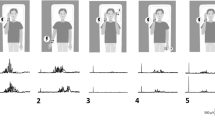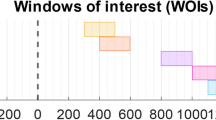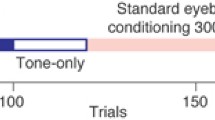Abstract
A reflex blink typically inhibits subsequent blinks. In this study, we investigated whether the nature and time course of this inhibition vary when different combinations of blink-evoking stimuli are used. We used the paired stimulus paradigm, in which two blink-evoking stimuli — a conditioning stimulus followed by a test stimulus — are presented with a variety of interstimulus intervals, to examine the interactions between blinks evoked by trigeminal and acoustic stimuli in rats and humans. In addition, we studied the effect of a blink-evoking trigeminal stimulus on subsequent gaze-evoked blinks in humans. The results revealed that long-lasting inhibition occurred when the conditioning and test stimuli were within the same modality. A shorter period of inhibition followed by facilitation occurred when the stimuli were in different modalities. The data demonstrate that a blink-evoking stimulus initiates a lengthy period of inhibition in its own sensory pathway and a shorter period of inhibition in the reticular formation and/or in blink motoneurons. In addition, the results show that the blink-evoking stimulus also initiates a facilitatory process. Thus, the magnitude of a blink reflects a balance between inhibitory and facilitatory processes.
Similar content being viewed by others
References
Anthony BJ (1985) In the blink of an eye: implications of reflex modification for information processing. Adv Psychophysiol 1: 167–218
Basso MA, Strecker RE, Evinger C (1993) Midbrain 6-hydroxydopamine lesions modulate blink reflex excitability. Exp Brain Res 94: 88–96
Borszez GS, Cranney J, Leaton RN (1989) Influence of long-term sensitization on long-term habituation of the acoustic startle response in rats: central gray lesions, preexposure and extinction. J Exp Psychol Anim Behav Process 15: 54–64
Canli T, Brown TH (1996) Amygdala stimulation enhances the rat eyeblink reflex through a short-latency mechanism. Behav Neurosci 110: 1–9
Davis M (1992) The role of the amygdala in conditioned fear. In: Aggleton J (ed) The amygdala: neurobiological aspects of emotion, memory and mental dysfunction. Wiley, New York, pp 255–305
Evinger C, Manning KA, Sibony PA (1991) Eyelid movements: mechanisms and normal data. Invest Ophthalmol Vis Sci 32: 387–400
Evinger C, Basso MA, Manning KA, Sibony PA, Pellegrini JJ, Horn AKE (1993) A role for the basal ganglia in nicotinic modulation of the blink reflex. Exp Brain Res 92: 507–515
Evinger C, Manning KA, Pellegrini JJ, Basso MA, Powers AS, Sibony PA (1994) Not looking while leaping: the linkage of blinking and saccadic gaze shifts. Exp Brain Res 100:337–344
Fox JE (1978) Excitatory and inhibitory components of the eyeblink responses to startle evoking stimuli, studied in the human subject. Electroencephalogr Clin Neurophysiol 44: 490–501
Hoffman HS, Ison JR (1980) Reflex modification in the domain of startle. I. Some empirical findings and their implications for how the nervous system processes sensory input. Psychol Rev 87: 175–189
Kimura J (1973a) Disorder of interneurons in parkinsonism: the orbicularis oculi reflex to paired stimuli. Brain 96: 87–96
Kimura J (1973b) The blink reflex as a test for brainstem and higher central nervous system function. In: Desmedt JE (ed) New development in electromyography and clinical neurophysiology, vol 3. Karger, Basel, pp 682–691
Leaton RN, Cranney J (1990) Potentiation of the acoustic startle response by a conditioned stimulus paired with acoustic startle stimulus in rats. J Exp Psychol Anim Behav Process 11: 421–428
Pellegrini JJ, Evinger C (1995) The trigeminally evoked blink reflex. II. Mechanisms of paired-stimulus suppression. Exp Brain Res 107: 181–196
Pellegrini JJ, Horn AKE, Evinger C (1995) The trigeminally evoked blink reflex. I. Neuronal circuits. Exp Brain Res 107: 166–180
Rimpel J, Geyer D, Hopf HC (1982) Changes in the blink responses to combined trigeminal, acoustic and visual repetitive stimulation, studied in the human subject. Electroencephalogr Clin Neurophysiol 54: 552–560
Sanes JN, Ison JR (1979) Conditioning auditory stimuli and the cutaneous eyeblink reflex in humans: differential effects according to oligosynaptic or polysynaptic central pathways. Electroencephalogr Clin Neurophysiol 47: 546–555
Sanes JN, Ison JR (1982) Conditions that affect the thresholds of the components of the eyeblink reflex in humans. J Neurol Neurosurg Psychiatry 45: 543–549
Snow BJ, Frith RW (1989) The relationship of eyelid movement to the blink reflex. J Neurol Sci 91: 179–189
Stitt CL, Hoffman HS, DeVido CJ (1980) Inhibition of the human glabella reflex by antecedent acoustic stimulation. Percent Psychophys 27: 82–88
Valls-Solé J, Cammarota A, Alvarez R, Hallett M (1994) Orbicularis oculi responses to stimulation of nerve afferents from upper and lower limbs in normal humans. Brain Res 650: 313–316
Author information
Authors and Affiliations
Rights and permissions
About this article
Cite this article
Powers, A.S., Schicatano, E.J., Basso, M.A. et al. To blink or not to blink: inhibition and facilitation of reflex blinks. Exp Brain Res 113, 283–290 (1997). https://doi.org/10.1007/BF02450326
Received:
Accepted:
Issue Date:
DOI: https://doi.org/10.1007/BF02450326




